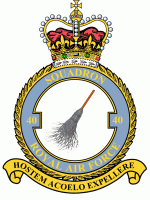40. RAF Squadron
No. 40 Squadron RAF
period of existence
40. RFC Squadron [1916-1918]
40. RAF Squadron [1918-1919]
40. RAF Squadron [1931-1947]
40. RAF Squadron [1947-1950]
40. RAF Squadron [1953-1957]
motto
Hostem coelo expellere (To drive the enemy from the sky)
history
The history of the unit begins to be written on February 26, 1916, when it was created at the airport Gosport. After completing his training, he moved to France in August of the same year and worked as a fighter unit there until the end of World War I. During the fighting, its pilots shot down 350 aircraft and balloons and a total of 24 of them became fighter aces (the most successful were Capt. GE McElroy (30) and Capt. EC Mannock (16)). In February 1919, the squadron returned to Great Britain, where it disappears on June 30, 1919.
On April 1, 1931, it was rebuilt at the base Upper Heyford, this time as a bombing unit. After the outbreak of World War II, it moved to France in September 1939, but in December it was withdrawn to Great Britain, where it was converted to aircraft Blenheim Mk.IV. After the invasion of France, enemy troops attacked their bases in Great Britain, and after the defeat of France, they attacked ports in occupied Europe. In November 1940, she was converted to heavy bombers Wellington and then conducted night raids on targets in Germany and occupied Europe. Since October 1941, part of the unit operates from Malta, from where they conduct raids on targets in Italy and North Africa. On February 14, 1942, part of the unit in Britain became 156. Squadron, number 40 passes to the crews in Malta. After heavy fighting and losses, she is withdrawn to the Suez Canal area to rest and replenish her condition, but soon returns to combat flights. In December, he moved to Italy, from where he operated until the end of the war. In October 1945 it was located in Egypt and on April 1, 1947 it expired.
As early as December 1, 1947, it was reactivated at the Abingdon base as a transport unit and soon became involved in supplying the besieged western part of Berlin. Shortly after the operation ended, it was disbanded on March 15, 1950.
So far, it was last restored on October 28, 1953, again as a bomber at the base Coningsby. On February 1, 1957, it was dissolved.
sources:
Halley, James J. The Squadrons of the Royal Air Force & Commonwealth 1918–1988. Tonbridge, Kent, UK: Air Britain (Historians) Ltd., 1988. ISBN 0-85130-164-9.
Jefford, Wing Commander C.G., MBE, BA, RAF (Retd.). RAF Squadrons, a Comprehensive record of the Movement and Equipment of all RAF Squadrons and their Antecedents since 1912. Shrewsbury, Shropshire, UK: Airlife Publishing, 1988 (second edition 2001). ISBN 1-85310-053-6.
Rawlings, John D.R. Coastal, Support and Special Squadrons of the RAF and their Aircraft. London: Jane's Publishing Company Ltd., 1982. ISBN 0-7106-0187-5.
https://en.wikipedia.org/wiki/No._40_Squadron_RAF
http://www.rafweb.org/Squadrons/Sqn036-40.htm
https://www.raf.mod.uk/history/40squadron.cfm
www.raf.mod.uk
www.historyofwar.org
http://www.epibreren.com/ww2/raf/40_squadron.html
http://www.rafcommands.com/Ross/Bomber/40B.html
http://www.lancaster-archive.com/bc_sqn-40.htm
www.theaerodrome.com
No. 40 Squadron RAF
period of existence
40. RFC Squadron [1916-1918]
40. RAF Squadron [1918-1919]
40. RAF Squadron [1931-1947]
40. RAF Squadron [1947-1950]
40. RAF Squadron [1953-1957]
motto
Hostem coelo expellere (To drive the enemy from the sky)
history
The history of the unit begins to be written on February 26, 1916, when it was created at the airport Gosport. After completing his training, he moved to France in August of the same year and worked as a fighter unit there until the end of World War I. During the fighting, its pilots shot down 350 aircraft and balloons and a total of 24 of them became fighter aces (the most successful were Capt. GE McElroy (30) and Capt. EC Mannock (16)). In February 1919, the squadron returned to Great Britain, where it disappears on June 30, 1919.
On April 1, 1931, it was rebuilt at the base Upper Heyford, this time as a bombing unit. After the outbreak of World War II, it moved to France in September 1939, but in December it was withdrawn to Great Britain, where it was converted to aircraft Blenheim Mk.IV. After the invasion of France, enemy troops attacked their bases in Great Britain, and after the defeat of France, they attacked ports in occupied Europe. In November 1940, she was converted to heavy bombers Wellington and then conducted night raids on targets in Germany and occupied Europe. Since October 1941, part of the unit operates from Malta, from where they conduct raids on targets in Italy and North Africa. On February 14, 1942, part of the unit in Britain became 156. Squadron, number 40 passes to the crews in Malta. After heavy fighting and losses, she is withdrawn to the Suez Canal area to rest and replenish her condition, but soon returns to combat flights. In December, he moved to Italy, from where he operated until the end of the war. In October 1945 it was located in Egypt and on April 1, 1947 it expired.
As early as December 1, 1947, it was reactivated at the Abingdon base as a transport unit and soon became involved in supplying the besieged western part of Berlin. Shortly after the operation ended, it was disbanded on March 15, 1950.
So far, it was last restored on October 28, 1953, again as a bomber at the base Coningsby. On February 1, 1957, it was dissolved.
sources:
Halley, James J. The Squadrons of the Royal Air Force & Commonwealth 1918–1988. Tonbridge, Kent, UK: Air Britain (Historians) Ltd., 1988. ISBN 0-85130-164-9.
Jefford, Wing Commander C.G., MBE, BA, RAF (Retd.). RAF Squadrons, a Comprehensive record of the Movement and Equipment of all RAF Squadrons and their Antecedents since 1912. Shrewsbury, Shropshire, UK: Airlife Publishing, 1988 (second edition 2001). ISBN 1-85310-053-6.
Rawlings, John D.R. Coastal, Support and Special Squadrons of the RAF and their Aircraft. London: Jane's Publishing Company Ltd., 1982. ISBN 0-7106-0187-5.
https://en.wikipedia.org/wiki/No._40_Squadron_RAF
http://www.rafweb.org/Squadrons/Sqn036-40.htm
https://www.raf.mod.uk/history/40squadron.cfm
www.raf.mod.uk
www.historyofwar.org
http://www.epibreren.com/ww2/raf/40_squadron.html
http://www.rafcommands.com/Ross/Bomber/40B.html
http://www.lancaster-archive.com/bc_sqn-40.htm
www.theaerodrome.com
